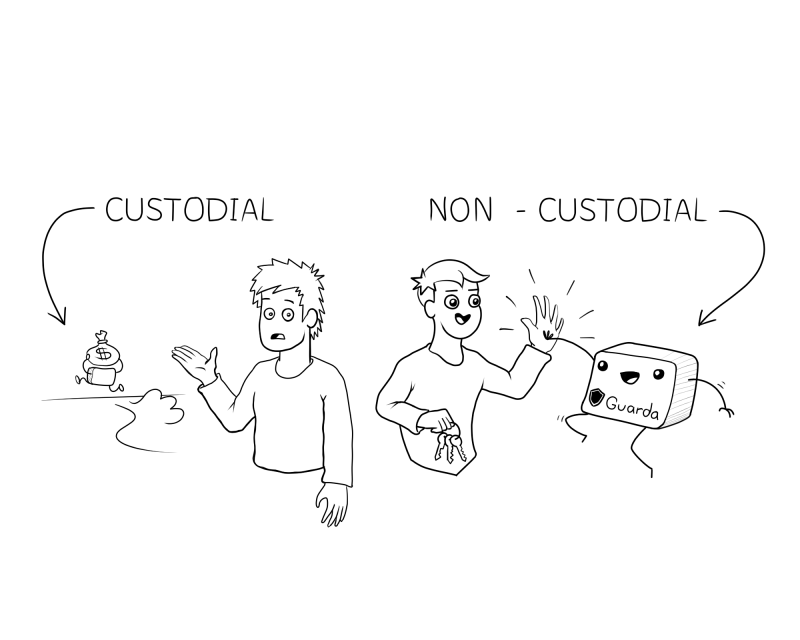⚡️Custodial vs Non-Custodial wallets⚡️ Benefits of light wallets

A wallet is the first thing you need in order to use cryptocurrency. A wallet is required not only to store your coins but also to perform any operations with cryptocurrencies. Today we will review custodial and light (non-custodial) wallets, and which of them is better for your personalized user experience and safety.
What is a custodial wallet?
A custodial wallet is a wallet in which your private keys are stored by a third party. Thus, you do not have full control over your funds, which makes these wallets a dubious choice.
However, they have some advantages:
- You can manage your funds very quickly and at any time when there is an Internet connection;
- No chance to lose your private key and lose access to your money;
Disadvantages:
- The custodian has control over your money;
- Your crypto-coins can be seized by a court decision;
- If your wallet gets hacked, your coins may go missing;
- In the case of a fork, there is a chance to not receive your coins.
The custodial wallet is very similar in its function to the principles of a bank, meaning you do not fully control your money inside of it. Yes, the money remains yours, but it is in the hands of another company.
Here are some examples of custodial exchanges, which provide you with a wallet to store your funds on their platform:
- Bitfinex is one of the largest cryptocurrency-related fintech companies. Nevertheless, in 2016, Bitfinex suffered the largest crash in history, when hackers stole 120 000 bitcoins, which Bitfinex had to compensate users for with its operating profit.
- Bithumb is the Korean crypto exchange. It supports 10 cryptocurrencies and is one of the leaders in trading volumes per day. In 2017, Bithumb was hacked, when 1.2 million Korean Won was stolen.
- Cryptsy was an American crypto-exchange founded by Paul Vernon. On the platform, it was possible to trade bitcoin and litecoin, but once Cryptsy suffered a hacker attack, which resulted in stolen coins totaling $5 million.
- Coinbase — the largest exchange for trading cryptocurrencies, which is also one of the few whose own accounts have never been hacked.
- Mt.Gox —the infamous crypto-exchange, was one of the first in the market and most affected by hacking. As a result, $8 million disappeared.
- BTC-e — the largest Russian exchange. In July 2017, it suddenly went offline, and its director was arrested.
- Poloniex — a quite well-known and large crypto-exchange with more than 100 cryptocurrencies for trading. In 2018, it has been actively attacked by scammers, trying to get access to user accounts.
- Kraken — an American exchange with 2F-authorisation. Still, during 2018, some of its clients have suffered from phishing.
And here are some custodial wallets:
- Freewallet — within the platform Freewallet users have the ability to create mobile cryptocurrency wallets to work with tokens. It has a variety of cryptocurrency options, including Bitcoin, Ethereum, DASH, Dogecoin, FantomCoin, Monero, DECENT, Lisk, NXT, Zcash, Steem, Ardor, DigitalNote, Bancor, Tether and other altcoins. In 2017, users started complaining that Freewallet had sent their money to unknown addresses.
- Blockchain.info is a partially centralized wallet. Still, it has suffered some major thefts — for example in February 2018, hackers stole 700 BTC.
- BTC.com — this application was the first mobile client of its kind designed not for stationary devices, but for tablets and smartphones. The client connects to the Bitcoin network directly, which eliminates the possibility of obtaining your confidential data and access to existing assets by third parties.
Light (Non-custodial) wallets
These may be web, paper, mobile, desktop and hardware wallets — as is the case with custodial ones. However light (non-custodial) wallets allow you to fully control your funds and therefore are more secure.
Web wallets — non-custodial web wallets do not keep your keys, they are stored in your browser. Such wallets as MyEtherWallet and Guarda allow you to access your account from any device, all you need to enter is your private key.
Hardware wallets are considered to be the most secure cryptocurrency storage solution. They are physical devices, similar to flash drives that don’t have access to the Internet. Thus, hackers cannot access these wallets.
Mobile Light wallets can be installed on a smartphone or a tablet. There are a huge number of such wallets, but you need to choose them carefully, paying attention to their security and authenticity. Before installing the wallet, be sure to read the reviews. In addition, it is recommended to download applications from the developer’s site — for example, at Guarda we have links to applications in the AppStore and Google Play, so you will be protected from the possibility of downloading a fake application.
A desktop wallet is an application that is installed directly on your computer. There are many such non-custodial programs, for example, Electrum and BitGo. Choose this type of program according to the cryptocurrency you need to store, and the operating system. You can use this wallet only when you are connected to the Internet. But since the keys are stored on the computer itself, there is a possibility of theft if the fraudster takes physical possession of your computer.
Paper wallets mean that you print your public and private keys on a piece of paper. Thus, the cryptocurrency is stored offline, but you can always connect to the network from any device and enter your keys. Storing the cryptocurrency on paper is like keeping money in cash under the bed.
So the custodial wallet is the easiest way to use cryptocurrency and does not require any knowledge from the user, but it is very unsafe. If you plan to store large amounts of money, it is better to choose a light (non-custodial) wallet.

